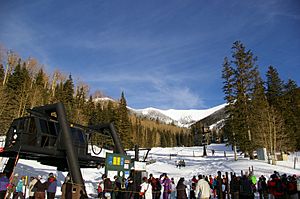Arizona Snowbowl facts for kids
Quick facts for kids Arizona Snowbowl |
|
|---|---|
 |
|
| Location | Coconino County, Arizona, United States |
| Nearest city | Flagstaff - 7 miles (11 km) |
| Coordinates | 35°19′48″N 111°42′18″W / 35.330°N 111.705°W |
| Vertical | 2,300 ft (700 m) |
| Top elevation | 11,500 ft (3,505 m) |
| Base elevation | 9,200 ft (2,805 m) |
| Skiable area | 777 acres (3.14 km2) |
| Runs | 48 |
| Longest run | 2.0 mi (3.2 km) |
| Lift system | 7 total - 6 chairs (1 high-speed six-pack, 1 quad, 2 triples, 2 doubles) 1 surface |
| Terrain parks | 1 |
| Snowfall | 260 in (660 cm) / year |
| Website | arizonasnowbowl.com |
Arizona Snowbowl is a popular ski resort located in the southwestern United States. It sits on the San Francisco Peaks in northern Arizona, about seven miles (11 km) north of Flagstaff. This resort is a great place for skiing and snowboarding.
Snowbowl first opened for skiing in 1938. The base of the resort is at 9,200 feet (2,805 m) above sea level. The top of the ski lifts reaches 11,500 feet (3,505 m). This means skiers can enjoy a 2,300-foot (700 m) vertical drop, which is the biggest in Arizona! The resort gets about 260 inches (660 cm) of snow each year. It has six chairlifts and two main lodges, called Hart Prairie Lodge and Agassiz Lodge.
Contents
The Story of Arizona Snowbowl
Skiing in the Flagstaff area began way back in 1915. Brothers Ole and Pete Solberg used skis they made themselves to glide down Mars Hill. Later, in 1938, the U.S. Forest Service gave permission to build a road and a ski lodge. This was on the western side of the San Francisco Peaks, in an area called Hart Prairie.
In 1941, a company called Arnal Corporation bought the ski facilities. They took over the special permit that allowed Snowbowl to operate. This permit is renewed every 40 years. The Arizona Snowbowl uses about 777-acre (3.14 km2) of land under this permit.
The San Francisco Peaks and Native American Tribes
The San Francisco Peaks are very important to 13 different Native American tribes. These tribes include the Dine (Navajo), Apache, Hualapai, Yavapai, and Hopi. They see the Peaks as a sacred place. For centuries, Native people have used the Peaks for ceremonies and religious activities. These activities are often connected to water and life cycles. The Hopi people, for example, have lived on this land since at least 1150.
Because the Peaks are sacred, many tribes have protested against the expansion of Snowbowl. They believe that more development harms their sacred areas. They also feel it affects their religious freedom.
Challenges and Court Cases
In 1979, the Forest Service approved plans for Snowbowl to grow. This included a new lodge, paved roads, more parking, and new ski lifts. It would also add 50 acres (0.20 km2) of new trails. The total ski area would become 777 acres (3.14 km2).
Native American tribes protested these plans. They argued that the expansion would damage their sacred land. The chairman of the Hopi tribe warned about the impact on their beliefs. Despite these protests, the Forest Service approved the paving of the access road in 1980.
The Hopi and Navajo tribes filed lawsuits to stop the development. They said their religious rights would be harmed. However, the courts did not agree. In 1983, the District of Columbia Circuit Court ruled against the tribes. The court said that while the expansion might offend their beliefs, it did not violate the American Indian Religious Freedom Act of 1978. The tribes also argued that the Forest Service was breaking other laws. These included the Endangered Species Act and the National Historic Preservation Act. They were concerned about using treated wastewater on the Peaks.
In 2008, a court initially sided with the tribes. But this decision was later overturned. The court allowed Snowbowl to use treated water to make artificial snow. They also approved new lifts, more trails, and lodge expansions. The tribes tried to appeal to the U.S. Supreme Court. However, the Supreme Court chose not to hear the case in 2009. This meant Snowbowl could continue with its plans.
Recent Protests and Changes
In 2011, construction began on a pipeline to bring treated water to Snowbowl. Native American and environmental groups started protesting again. Some people are concerned about the treated water used for snowmaking. They worry it might affect human health or water quality in streams. However, no scientific studies have confirmed these concerns. Many people were arrested during these protests.
In 2014, the city of Flagstaff approved a 20-year deal to sell treated water to Snowbowl. The Hopi Tribe filed another lawsuit to challenge this sale. Also in 2014, a group led by James Coleman bought Snowbowl. This group also owns other ski areas. In 2015, Snowbowl announced big plans for improvements. These included adding a new high-speed chairlift.
Native American tribes and groups like Protect the Peaks continue to protest. In 2014 and 2015, protests with many people took place when Snowbowl opened. Supporters of artificial snow say it helps Snowbowl stay open longer. This brings more tourists and helps Flagstaff's economy.
Snowbowl's Impact on the Local Economy
Arizona Snowbowl does not share its exact earnings publicly. However, it plays a role in the Flagstaff economy. The resort provides about 200 full-time jobs. It also contributes about $12.08 million to the city's economy. Using Artificial snow helps Snowbowl open earlier in winter. It also allows them to stay open later into spring. This helps ensure a longer ski season for visitors.
Images for kids





